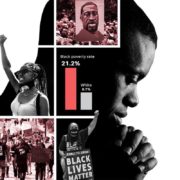By Mabinty Quarshie, N’dea Yancey-Bragg, Anne Godlasky, Jim Sergent, and Veronica Bravo, USA TODAY
When people talk about systemic racism, they mean systemic: impacting institutions, policies and outcomes across all aspects of Black Americans’ lives.
Black people have long suffered from persistent inequality in the United States due to centuries of racism, discrimination and the long-lasting effects of slavery. This has created conditions that make it difficult for Black Americans to get ahead.
Systemic racism — at times called structural racism or institutional racism — is “the complex interaction of culture, policy and institutions that holds in place the outcomes we see in our lives,” says Glenn Harris, president of Race Forward. Systemic racism leads to disparities in many “success indicators,” he says, including wealth, health, criminal justice, employment, housing, political representation and education.
And numbers from official sources over decades of time back this up.
Here are one dozen charts, showing how inequities impact not just Black Americans’ quality of life, but length of life.
Disparities start in the delivery room …
Black women die 3 times more often giving birth
Pregnancy-related deaths per 100,000 live births

Featured Image, USA TODAY
Full article @ USA TODAY


You must be logged in to post a comment.